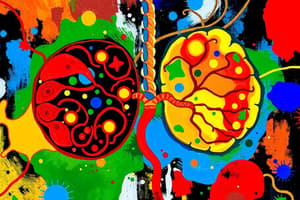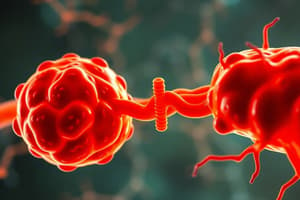Podcast
Questions and Answers
What is the net ATP gain from substrate-level phosphorylation during glycolysis?
What is the net ATP gain from substrate-level phosphorylation during glycolysis?
- 6 ATP
- 4 ATP
- 0 ATP
- 2 ATP (correct)
How many NADH molecules are produced during glycolysis from one glucose molecule?
How many NADH molecules are produced during glycolysis from one glucose molecule?
- 1
- 2 (correct)
- 3
- 4
What is the primary mechanism of ATP production in the electron transport chain?
What is the primary mechanism of ATP production in the electron transport chain?
- Fermentation
- Substrate-level phosphorylation
- Photophosphorylation
- Oxidative phosphorylation (correct)
What is the total ATP yield from one glucose molecule after accounting for shuttle costs?
What is the total ATP yield from one glucose molecule after accounting for shuttle costs?
Which phase of cellular respiration directly produces the most ATP?
Which phase of cellular respiration directly produces the most ATP?
What role does NADH play in cellular respiration?
What role does NADH play in cellular respiration?
During substrate-level phosphorylation, where does the energy for ATP production primarily come from?
During substrate-level phosphorylation, where does the energy for ATP production primarily come from?
In which part of cellular respiration is glucose oxidized?
In which part of cellular respiration is glucose oxidized?
What is the primary outcome of the first phase of glycolysis regarding ATP?
What is the primary outcome of the first phase of glycolysis regarding ATP?
Which of the following accurately describes substrate-level phosphorylation?
Which of the following accurately describes substrate-level phosphorylation?
What is the formula for pyruvic acid produced from glycolysis?
What is the formula for pyruvic acid produced from glycolysis?
How many molecules of NADH are produced during glycolysis?
How many molecules of NADH are produced during glycolysis?
In glycolysis, what happens to the hydrogen atoms associated with glucose?
In glycolysis, what happens to the hydrogen atoms associated with glucose?
During which phase are the 3-carbon fragments oxidized and ATP is formed?
During which phase are the 3-carbon fragments oxidized and ATP is formed?
What is the total ATP yield from glycolysis including the consumed ATP?
What is the total ATP yield from glycolysis including the consumed ATP?
What two byproducts are formed from glucose oxidation that have yet to appear in glycolysis?
What two byproducts are formed from glucose oxidation that have yet to appear in glycolysis?
What is the primary product of glycolysis?
What is the primary product of glycolysis?
How many ATP molecules are generated from one NADH + H+ during oxidative phosphorylation?
How many ATP molecules are generated from one NADH + H+ during oxidative phosphorylation?
Which process involves the formation of glucose from noncarbohydrate precursors?
Which process involves the formation of glucose from noncarbohydrate precursors?
How much ATP is generally produced from one FADH2 during oxidative phosphorylation?
How much ATP is generally produced from one FADH2 during oxidative phosphorylation?
What is the total maximum yield of ATP from the complete oxidation of one glucose molecule?
What is the total maximum yield of ATP from the complete oxidation of one glucose molecule?
Which shuttle mechanism is responsible for transporting NADH electrons into the mitochondria?
Which shuttle mechanism is responsible for transporting NADH electrons into the mitochondria?
Which of the following statements is true regarding the efficiency of FADH2 in ATP production?
Which of the following statements is true regarding the efficiency of FADH2 in ATP production?
When glycolysis occurs outside the mitochondria, what is the consequence for NADH + H+ production?
When glycolysis occurs outside the mitochondria, what is the consequence for NADH + H+ production?
Flashcards are hidden until you start studying
Study Notes
Cellular Respiration and Energy Production
-
NADH + H+ and FADH2 are electron carriers that feed into oxidative phosphorylation, generating approximately 28 ATP molecules.
-
Each NADH + H+ molecule generates about 2.5 ATP molecules through the proton gradient.
-
The two NADH + H+ molecules produced during glycolysis yield 5 ATP.
-
The 8 NADH + H+ molecules generated during the transition reaction and the citric acid cycle produce 20 ATP.
-
FADH2 is less efficient than NADH + H+ because it donates electrons to a lower energy level in the electron transport chain (at complex II).
-
Each FADH2 generates around 1.5 ATP, resulting in 3 ATP from the 2 FADH2 molecules produced in the citric acid cycle.
-
The complete oxidation of one glucose molecule to CO2 and H2O through substrate-level phosphorylation and oxidative phosphorylation yields a maximum of 32 ATP molecules.
-
There is uncertainty about the exact ATP yield from the NADH + H+ produced during glycolysis outside the mitochondria.
-
The inner mitochondrial membrane is impermeable to reduced NADH, requiring shuttle molecules to transfer electrons to the electron transport chain.
-
Some shuttles (like the glycerol phosphate shuttle) have an energy cost of 1 ATP per NADH, while others seem to provide a "free ride."
-
Cellular respiration does not result in unlimited ATP synthesis, as cells cannot store large amounts of ATP.
-
Aside from cellular respiration, carbohydrate metabolism focuses on maintaining the right glucose level in the blood, involving three key processes:
Glycogenesis
- Polymerizes glucose to form glycogen
Glycogenolysis
- Hydrolyzes glycogen to glucose monomers
Gluconeogenesis
- Forms glucose from noncarbohydrate precursors
-
Glycolysis, the first stage of glucose metabolism, converts glucose to pyruvate (pyruvic acid).
-
During glycolysis, 4 ATP molecules are produced, but 2 are consumed for activation energy, resulting in a net gain of 2 ATP.
-
Each pyruvate molecule (C3H4O3) contains four hydrogen atoms, whose electrons are bound to two molecules of NAD (NADH).
-
While glycolysis generates some ATP, energy from the remaining products (H2O and CO2) is not harvested until later stages.
-
The energy flow in cellular respiration follows this sequence: glucose -> NADH + H+ -> electron transport chain -> proton gradient energy -> ATP.
-
Substrate-level phosphorylation contributes a net gain of 4 ATP (2 from glycolysis and 2 from the citric acid cycle).
-
Oxidative phosphorylation generates approximately 28 ATP from electron transport chain activity and proton gradient energy.
-
Taking into account potential shuttle costs (2 ATP), the typical ATP yield per glucose molecule is estimated to be 30 ATP.
-
The proton gradient is also used for other cellular processes, so the actual ATP yield may be less than 30 ATP.
Studying That Suits You
Use AI to generate personalized quizzes and flashcards to suit your learning preferences.




